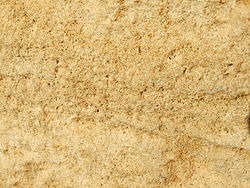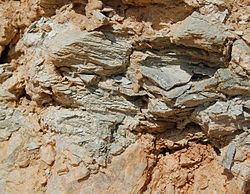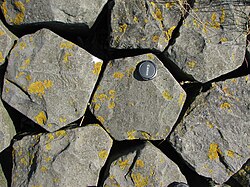Rock gypsum (Lucas Formation, Middle Devonian; Paulding County, Ohio, USA) 4
Sedimentary rocks form by the solidification of loose sediments. Loose sediments become hard rocks by the processes of deposition, burial, compaction, dewatering, and cementation.
There are three categories of sedimentary rocks: 1) Siliciclastic sedimentary rocks form by the solidification of sediments produced by weathering & erosion of any previously existing rocks. 2) Biogenic sedimentary rocks form by the solidification of sediments that were once-living organisms (plants, animals, micro-organisms). 3) Chemical sedimentary rocks form by the solidification of sediments formed by inorganic chemical reactions. Most sedimentary rocks have a clastic texture, but some are crystalline.
Rock gypsum (also known as gyprock) is a chemical sedimentary rock. It is an example of an evaporite - it forms by the evaporation of water (usually seawater) and the precipitation of dissolved minerals. Rock salt & rock gypsum often occur together in evaporitic successions. Rock gypsum is composed of the mineral gypsum (CaSO4·2H2O - hydrous calcium sulfate). Heating of gypsum or rock gypsum drives off the water, leaving only calcium sulfate behind (the mineral anhydrite). Adding water to anhydrite results in the formation of gypsum again.
Rock gypsum, unlike rock salt, does not have a salty taste, and is softer (H = 2) - it can be scratched with a fingernail. Rock gypsum’s color is often a mottled whitish-light grayish-light brownish. It is usually microcrystalline and powdery looking (it’s much finer-grained than typical rock salt deposits). Rock gypsum superficially resembles chalk. Chalk is calcitic, and so will bubble in acid - rock gypsum does not bubble in acid. Rock gypsum samples vary from extremely friable to moderately solid.
Stratigraphy: attributed to the Lucas Formation, Middle Devonian
Locality: undisclosed site in Paulding County (likely a quarry), northwestern Ohio, USARelevante Bilder
Relevante Artikel
Gestein des JahresGestein des Jahres ist eine Auszeichnung, die seit 2007 vom Berufsverband Deutscher Geowissenschaftler (BDG), anfänglich zusammen mit der Deutschen Gesellschaft für Geowissenschaften (DGG), verliehen wird. Die Verleihung erfolgt nach Vorschlag durch das Kuratorium Gestein des Jahres, in dem neben Vertretern des BDG auch Experten aus geologischen Landesämtern, der Bundesanstalt für Geowissenschaften und Rohstoffe, aus dem Geotourismus sowie der Rohstoff- und Natursteinindustrie sitzen. Ziel ist es, Gesteine sowohl hinsichtlich ihrer geologischen Entstehung als auch in ihrer Nutzung in Wirtschaft und Gesellschaft – sowie die Geologie und die Geowissenschaften insgesamt – der Öffentlichkeit zu präsentieren, im Wesentlichen durch themenbezogene Veranstaltungen und Publikationen. .. weiterlesen















